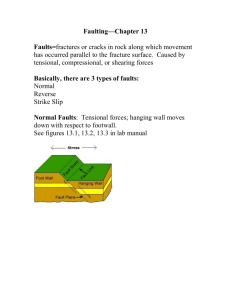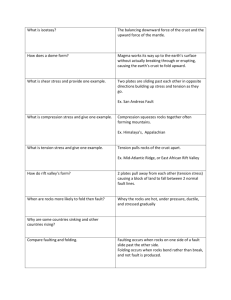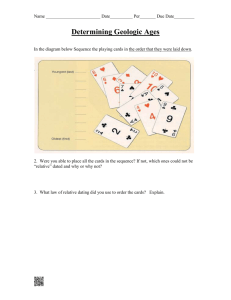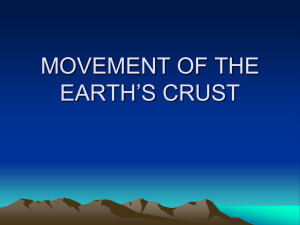stress
advertisement
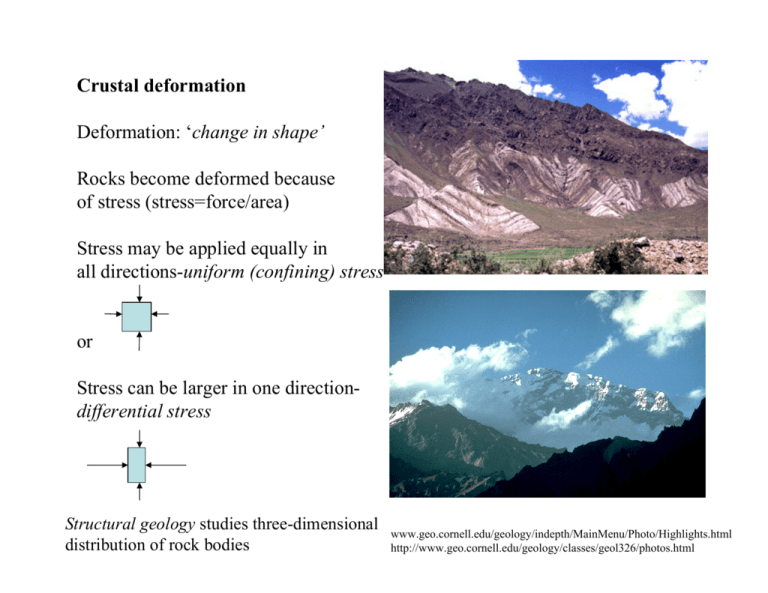
Crustal deformation Deformation: ‘change in shape’ Rocks become deformed because of stress (stress=force/area) Stress may be applied equally in all directions-uniform (confining) stress or Stress can be larger in one directiondifferential stress Structural geology studies three-dimensional distribution of rock bodies www.geo.cornell.edu/geology/indepth/MainMenu/Photo/Highlights.html http://www.geo.cornell.edu/geology/classes/geol326/photos.html Types of stresses Uniform (confining) stress Differential stress (tensional, compressional, shearing) http://earthsci.org/education/teacher/basicgeol/deform Strain: change is a body of rock caused by stress Elastic: rock (or other material) returns to its original shape after stress is removed Plastic: rock (or other material) deforms permanently by bending without being broken Brittle: rock (or other material) deforms permanently by fracturing and breaking down e ti l duc c s ti el a el a s ti c ti l duc e At lower temperatures, lower confining pressures and high strain rates rocks tend to be brittle At higher temperatures, higher confining pressures and lower strain rates rocks tend to exhibit ductile behavior Rock type is also important: some rocks such as salt, gypsum, shale are likely to behave in a ductile manner. On the other hand, quartzite, granite and basalt are brittle. The behavior depends on rock texture and mineral composition http://earthsci.org/education/teacher/basicgeol/deform/deform.html#NormalFaults Rock response to stress: folding and faulting Folds: wavelike bends in rocks that are mostly the result of compressional stress. Faults: fractures in rocks along which the displacement took place. Faults form in response to compressional, tensional and shearing stress. fault folds folds Folded structure, Appalachian Mountains http://www.geo.cornell.edu/geology/classes/geol326/photos.htmlans Anticline: upfold Syncline: downfold b lim Axial plane separates fold as symmetrically As possible b lim b lim Fold axis: intersection of axial plane with Surface of the fold Fold classes based on their appearance: - Symmetrical - Asymmetrical - Isoclinal (limbs are parallel) - Overturned - Recumbant - Chevron homepage.usask.ca /earthsci.org/education/teacher/basicgeol/deform Plunging folds: axis is not horizontal Plunging fold (anticline), California Photo by M. Collier homepage.usask.ca www.earthscienceworld.org/images Turbuck & Lutgens, 2002 Domes and Basins Very large circular or elliptical areas of upwarped (dome) or downwarped (basin) rocks where rocks are gently sloping away from the area of maximum uplift (dome) or toward the area of maximum subsidence (basin) Basins: Illinois and Michigan Domes: Black Hills of South Dakota eps.mcgill.ca Faults Fault types: - dip-slip: vertical movement - strike-slip: horizontal movement - oblique-slip: both vertical and horizontal 1994 W. H. Freeman and Company textbook, Understanding Earth, by Press and Siever Stress type and faulting Dip-slip faults Have footwall and hanging wall Subdivided into: - normal (footwall moves up) - reverse (footwall moves down) - thrust: shallow-angle reverse fault (less than 450 dip) Normal faults (tensional stress) Geologic structures resulting from normal faulting: half-grabens, horsts and grabens Landscapes caused by normal faulting earthsci.org/education/teacher/basicgeol/deform/deform.html#NormalFaults Tarbuck and Lutgens, 2002 Reverse and thrust faults (compressional stress) Strike-slip faults Left-lateral: ground on the other side of the fault moves to the left Right –lateral: ground on the other side of the fault moves to the right Monoclines: ‘blind’ fault deforms rocks above Tarbuck & Lutgens, 2002 Evidence of movements along the faults - landscape features (e.g. mountains and valleys, offsets or sharp bends in streams) - smooth fault planes at the surface - position of rock layers shifted along the fault - changes in rocks around the fault, e.g. slickensides and fault breccia Rocks become broken because of movement along the fault (fault breccia) Slickensides: parallel striations on the rock surface indicating movement www.geos.ed.ac.uk www.earthscienceworld.org/images Joints: fractures with no displacement Caused by: -Weathering (e.g. when igneous rocks become exposed) -Stress Occur in parallel sets Make rocks weaker Mineral deposits are often emplaced along joints Affect groundwater movement http://www.pitt.edu/~cejones/Geoimages/7Structures.html Reverse faults Normal fault Thrust fault San Andreas Fault strike-slip fault (California) www.pitt.edu/~cejones/Geoimages/7Structures.html pubs.usgs.gov www.geo.cornell.edu/geology/classes/geol326/photos.html Mapping geological structures: Brunton compass, strike and dip Orientation of rock layers and faults is mapped using strike and dip Geologic map and cross section showing strike and dip Strike: compass direction of a line produced by intersection of rock (or fault) surface and horizontal plane Dip: angle and compass direction of inclination of rock (or fault) wardsci.com homepage.usask.ca Geologic maps Show rock units, their ages and geologic structures http://wrgis.wr.usgs.gov/docs/usgsnps/gmap/gmap3.html#strike Geophysics and Crustal Deformation Geophysics: study of the Earth by physical methods, e.g. seismic, radar, electromagnetic and radioactivity methods Radar remote sensing Hydro-seismic surveys Seismic surveys on land Subsurface structure based on seismic reflection data http://geopubs.wr.usgs.gov/open-file/of02-368/, http://pangea.stanford.edu/GP/research/crustaldeform.html Geologic structures and man-made structures Vaiont Dam disaster, (NE Italy, 1963): A block of rock (270 m m3) slid into the lake along the bedding plane resulting in devastating flood (2500 dead) Damage to the dam as a result of vertical movement along the fault (Chi-Chi earthquake, Taiwan, 1999) Subsidence in Anchorage (~11 ft) as a result of landslide following 1964 earthquake www.geocities.com/geogsoc2000/Vaiont1.htm www.earthscienceworld.org

